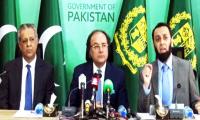ISLAMABAD: Implementation of donor-funded projects in Pakistan takes more time than in East Asian countries, a well-paced source said on Monday, citing a World Bank’s latest assessment report; although the newly-elected government attributed the slow development pace to political transition.
“The project implementation takes 3 to 4 years in case of East Asian countries while in case of Pakistan this timeframe stands in the range of 7 to 8 years,” the source, privy to the project assessment report of the multi-lender institution, told a select group of journalists.
“We think that the newly-elected government is taking adjustment time and there will be improvement on donor-funded projects,” the source added.
A World Bank’s official, however, justified the slower pace of implementation with regards to multi-billion dollars Dasu hydropower project that “got delayed due land procurement issue,” and its timeframe has to be revised accordingly. The project with installed capacity 4,320 megawatts is partly funded by the World Bank.
A spokesperson at the finance ministry said the country faced political transition during the current fiscal year and there was initially suspension of development activities by the Election Commission of Pakistan.
“For quite many months project approving forums i.e. CDWP (Central Development Working Party) and Ecnec (Executive Committee of National Economic Council) were not in place,” the spokesperson said in a statement. “Consequently various projects – both ongoing and in the pipeline – were adversely affected.”
The ministry’s official said the World Bank’s financing was also adversely affected due to introduction of hybrid financing instruments by the bank and the capacity constraints of the implementing entities to achieve compliance with bank procedures.
“The government is cognizant of the slow pace of disbursement of external economic assistance during the first six months of the current financial year,” the official added. “Pace of disbursement is usually slow during the first two quarters of the fiscal year.”
The finance ministry’s spokesperson further said the government has not budgeted the estimates of $2.3 billion from the World Bank during the current fiscal year. The data didn’t show such level of disbursement from the World Bank in a single year in the past.
The official said the government is not relying on short-term commercial loans, which are usually expensive, and add to debt vulnerability of the country. “Friendly countries have placed time deposits with the central bank of Pakistan at rates which are much lower than the commercial borrowing rate,” the official added. “These friendly deposits are on one hand augmenting official foreign exchange reserves while on the other saving significant cost of financing the reserve build up.”
The ministry’s official said short-term commercial borrowing is not a substitute of development financing. The government resorts to short-term commercial borrowing only as a contingency measure to stabilise foreign exchange reserve, while development financing is inexpensive and long-term source of financing for completing development projects in multiple sectors of economy.
Actual inflows from multilateral and bilateral sources were $4.7 billion in the last fiscal year of 2017/18 as against budget estimates of $6.094 billion. Budget estimates of external economic assistance through bilateral and multilateral development partners are $4.6 billion for FY2019. The government received $2.3 billion during the first seven months of FY2019 as against $2.6 billion a year earlier.
The official said the government has revised up annual foreign economic assistance estimates to $5.6 billion. “The government is confident of achieving the total target of $5.6 billion by June 2019,” the official said. “For this purpose a vigorous monitoring and portfolio review activity is currently being taken on ongoing basis. Project by project specific issues are being addressed with the relevant stakeholders both at federal and provincial level.” The portfolio review meetings are being conducted every month unlike the past when they were quarterly held.
A Nestlé office seen in this undated image.—The News/File LAHORE: Nestle Pakistan has released its 2023 Creating...
An undated image of a gold set displayed at a jewellery store. — AFP/FileKARACHI: Gold prices increased by Rs2,500...
Institute of Chartered Accountants of Pakistan building seen in this undated photo. — Business Recorder/FileKARACHI:...
A representational image of the SECP logo. — X/@SECPakistan/FileISLAMABAD: The Securities and Exchange Commission of...
A representational image showing farmers harvesting wheat crops in a field. — AFP/FileISLAMABAD: The Federation of...
A foreign currency dealer counts US dollar notes at a currency market in Karachi on July 19, 2022. — AFPNew York:...







